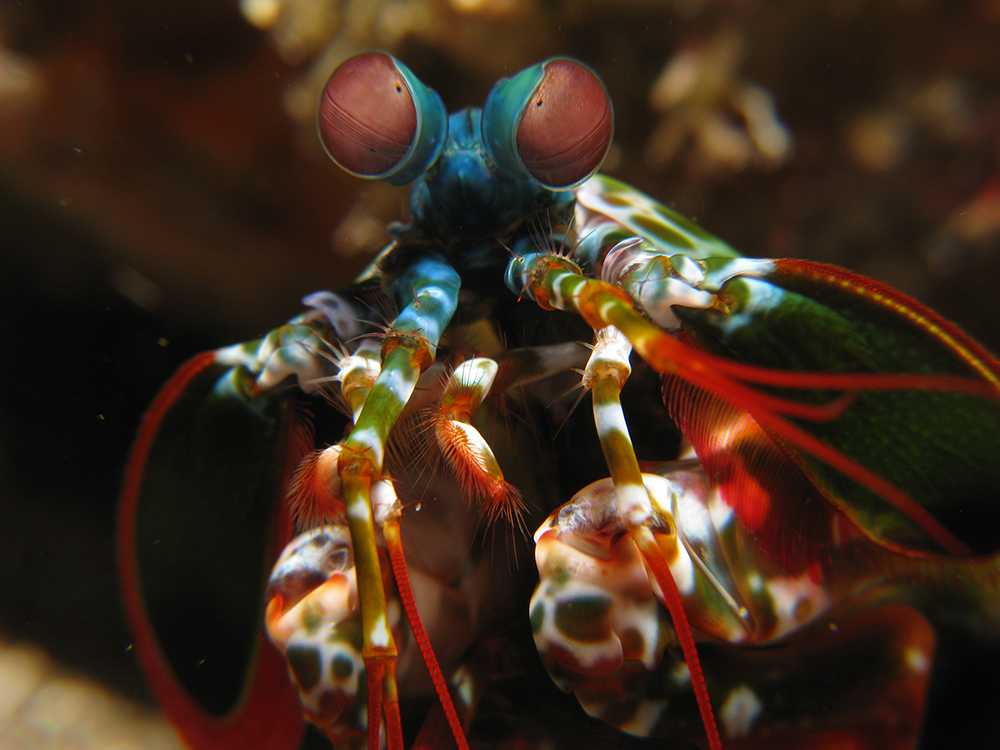On mantis shrimp and Monet
If you are in Mr. Cross’s Physics class (or if you applied to the University of Chicago), then you’ve heard of the mantis shrimp. Its independently-swiveling eyes have sixteen different types of photoreceptor cells (while we have only two), ranging far into the infrared and ultraviolet spectrum; they can even differentiate between polarized and unpolarized light. And everyone always says how trippy their world must be.
In Biology and Physics, we learn how our own sight works: wavelengths, rods and cones, emission spectra. We can’t see light outside the visible spectrum because our eyes simply weren’t made for it. Even within that spectrum, we technically only see three wavelengths; we only perceive Barney’s distinctive purple tint because it partially stimulates both our red and blue cones. But that got me thinking: if we can “see” these colors that we technically aren’t equipped for, what about others? If some future marvel of genetic engineering gave us the mantis shrimp’s multispectral eyes, what would we see?
My first reaction was that we wouldn’t. Try as I might, I just can’t imagine another color. My brain cannot conceive of some shade that lies outside the RGB spectrum. What does infrared light look like? I have no idea.
But then I realized that I have seen infrared light. Just as I have seen x-rays.
Now, you may argue that thermal cameras or x-ray scanners are more than just eye enhancements. They don’t just pick up infrared or x-ray light and send it to our brain—they interpret it, changing it into the pixels on a monitor or the ink on a printout, which is now within our visible spectrum. So we’re not really seeing these other wavelengths. But how is this different from how our brain functions? The retina doesn’t send light, it sends electrical impulses. Our brain reinterprets this into images. It even effortlessly corrects the image; our lenses flip it upside down, our brain flips it back up.
So who’s to say our brain wouldn’t be able to reinterpret these wavelengths into the colors we are so familiar with? Just ask Claude Monet.
“Monet? What does an impressionist painter have to do with light spectra?”
Well, he could see ultraviolet light. In fact, we all can. We just don’t because our lenses filter it out. Monet had his crystalline lens removed, presumably for cataracts. And while I share this dubious honor with him, I live in a concrete jungle where everything is built to be within our normal visible spectrum. Monet didn’t. He was constantly wandering around plants and flowers, which make ample use of UV light and patterns. So his paintings later in life made use of it. How were they different, you may ask?
They were purple.
His brain understood ultraviolet light as purple. So who’s to say that super-eyes wouldn’t let us see salmon x-rays, or turquoise microwaves, or lavender radio waves?
So the mantis shrimp’s mysterious multispectral world might not be so alien after all. Sure, maybe we can’t check what’s on the radio just by looking up. Maybe we can’t just shine an x-ray lamp on our arm to check our bones. But there’s no reason to think it’s beyond our brain’s capacity. Maybe we just need better eyes.
Biomedical engineers, I’m looking at you. Get on it.
That said, I think we’re still a long way away from being able to swing our claws so fast that it creates cavitation bubbles, or take out prey even when we miss through the sheer force of the shockwave caused.
I’ll let you take that one, mantis shrimp.












